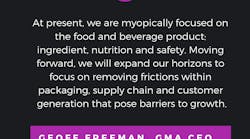The new year also brings change to the Grocery Manufacturers Association – although change there really began with the hiring of a new CEO, Geoff Freeman, in mid-2018.
In the 12 months preceding his hiring, 11 of the biggest companies in GMA quit the trade association. While most were circumspect about why they quit, there were hints they felt GMA was getting too political, too defensive on many consumer-facing issues.
Campbell Soup’s then-CEO, Denise Morrison, was clear when she made Campbell the first to leave that she felt GMA had lost its way, especially on the subject of GMOs and other transparency issues. Campbell was followed by Nestlé USA, Dean Foods, Mars, Tyson Foods, Unilever, Hershey Co., Cargill, Kraft Heinz Co., Danone North America and DowDuPont.
[pullquote]
Without any expressed connection, CEO Pamela Bailey announced last February she would retire once a replacement was found. That replacement arrived Aug. 1, 2018, in the person of Freeman, who had been president/CEO of the American Gaming Assn. (AGA), the trade association for the U.S. casino gaming industry.
In addition to Bailey, Chris Policinski, then CEO of Land O’Lakes and chairman of GMA for several years, also retired, from both his GMA post and from Land O’Lakes. Vivek Sankaran of Frito-Lay replaced him as chairman of GMA.
So GMA’s top two leaders are both new.
After surveying the landscape for a few months, Freeman wrote a message to GMA members last November:
“My first 100 days at GMA have been productive – listening to voices across the industry, identifying areas of common cause and putting in place a high-performing team. Day-by-day, with the help of new senior leadership, we are pivoting from defense to offense. We have analyzed critical functions, targeted key investments and addressed gaps in strategy with a single goal in mind: building an association that is indispensable to the industry.”
In “defining who we are,” he clearly says the association belongs to brands, apparently not “food service and private label to agricultural components.” “I firmly believe that GMA’s best strategy is to become the association of consumer-facing brands. This defines our common ground — the challenges, risks and opportunities we all share and complex relationships with consumers, retailers and governments we all must manage.
“At present, we are myopically focused on the food and beverage product: ingredient, nutrition and safety. Moving forward, we will expand our horizons to focus on removing frictions within packaging, supply chain and customer generation that pose barriers to growth.”
He acknowledges GMA has developed a defensive nature. “When it comes to external engagement, we are currently operating on playing fields defined by our opponents — reacting to their critiques, rather than establishing our own objectives; allowing them to set the terms of debate, rather than driving a winning result based on terms we define.”
He says GMA must “tell the industry’s story on our terms. Our industry’s massive economic footprint and vast social contributions improve communities across America. Yet instead of aggressively communicating these benefits, GMA is silent. Our critics, on the other hand, relentlessly shape a counter narrative about ‘Big Food’ – and they are winning. Their voices, left to echo through our silence, define our industry as indifferent or even hostile to the needs of consumers. Brands effectively connect with consumers about their shared values; the broader CPG industry must do the same by confidently telling our industry’s story on our own terms.”
He then goes on to outline a strategic plan for GMA, most of the points tactical and internal (read it on the GMA site). But the bigger point: “I am convinced that GMA’s best days are ahead. Change will not always come as quickly or easily as we would like, but I am confident that a trade organization focused on an advocacy agenda, supported by the right organizational structure and committed to driving greater industry growth is precisely what our industry needs today.”
And one focused on getting its members to deliver what consumers want and need, not the other way around.
